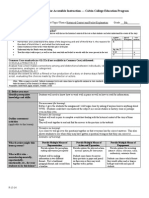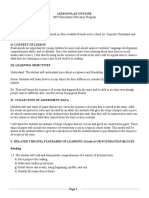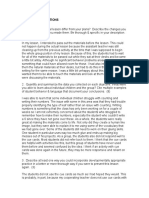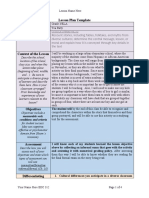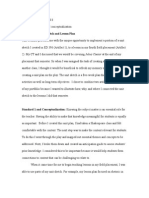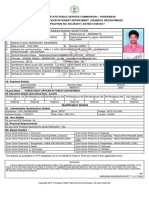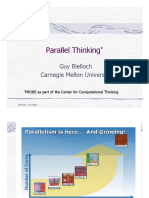Post-Observation Conf Form
Uploaded by
api-211991974Post-Observation Conf Form
Uploaded by
api-211991974OYSTER BAY-EAST NORWICH CENTRAL SCHOOL DISTRICT
Post-Observation Conference
Name of Teacher _____Emily Hawe_________ School ________High School___________ Grade Level/Subject:__7th Grade English___Observer___Dr. Mulhall____ Observation Date_________________ Post-Observation Conference Date______________
1.
In general, how successful was the lesson? Did the students learn what you intended for them to learn? How do you know? (3d, 4a) As a whole, I believe this lesson was successful in that it introduced students to the idea of symbolism in literature. With varying levels of assistance, nearly the whole class was able to identify and analyze the symbolic elements of the black box in The Lottery. Their learning was reflected in the graphic organizers they completed in which they analyzed the symbolic meaning of descriptions about the black box. This graphic organizer then became the basis of an essay in response to the following question: What message is Shirley Jackson sending about tradition through the symbol of the black box? So far their essays are demonstrating a consistent understanding of how the black box operates as a symbol and how they must support their analysis with textual evidence.
2. If you were able to bring samples of student work, what do those samples reveal about those students levels of engagement and understanding? (3d, 3c) I found that the graphic organizers produced by students could be organized into three categories. About a third of the class was able to analyze the symbolic meaning of the black box and insightfully analyze how the author used symbolism to communicate a theme. Example: Shirley Jackson described the box as faded and falling apart to show how the tradition is weakening over time. This fits with the story because the tradition of the lottery is weakening since other towns are stopping the tradition. Almost all of the other students were able to analyze the symbolic meaning of the black box and connect it to the theme of the story, but their connection might have required prompting or been less nuanced than the top third. Example: Shirley Jackson described the box as faded and falling apart to show how the tradition is weakening over time. This shows that traditions can change and weaken over time.
Only two students fell into the last category of struggling to see how the black box could represent abstract ideas. Example: The black box symbolizes the lottery. Given the developmental level of 7th graders, I am not surprised by this result, as many 7th graders, particularly this early in the year, struggle with more abstract thinking.
3. Comment on your classroom procedures, student conduct, and your use of physical space. To what extent did these contribute to student learning? (2c, 2d, 2e) One of the most important procedures in my class is the beginning of class procedure. Students are expected to take a handout from the Take One bin and begin work on the do now immediately. All instructions are always posted on the board along with a timer. This procedure is one that we have struggled with this year, and I have found that students need frequent reminders of the routine. I was also finding that students spent the majority of the activator time shuffling through their binders and preparing a piece of paper. After several different attempts to remedy this loss of time, I have recently begun providing students with a handout each day on which they complete the do now and all of their classwork for the day. I am still debating whether this is coddling them too much, but it has made our use of class time more productive. The daily note sheet seems to serve as an anchor for students and helps them focus on the lesson and associated activities more. Student completion of classwork has improved significantly since implementing the daily note sheet. The most significant way I use the physical space of the classroom is having students gather at the front of the room for the mini-lesson. We spent time at the beginning of the year practicing this transition and learning what is expected of students during a mini-lesson. When they come to the carpet, they know that they are expected to show intense focus for the duration of the mini-lesson. When they return to their desks, they know that they will be asked to actively apply what we learned during the mini-lesson. I also arrange student desks to facilitate learning. At times I group desks into clusters of four or six desks for group discussions or station work. I have found that individual engagement while learning a new concept is highest when students are working with one partner rather than a larger group. For this lesson, students worked with one partner so that every child had to be actively engaged in the activity.
4. Did you depart from your plan? If so, how, and why? (3e) I spent a little bit longer than I had originally intended discussing the do now because I noticed that some students were having difficulty distinguishing between literal and symbolic meaning. I wanted to make sure that they had a solid grasp of the idea that a concrete object can represent an abstract idea before they began analyzing the text.
I also adjusted the lesson plan after my first period class to include a class reading of a specific passage about the black box. I found that in my first period class, students lost time sifting through the story for pertinent details. I decided to review that specific passage because it had plenty of material for students to work with and was a good way to refresh their memory of the story after their fieldtrip. 5. Comment on different aspects of your instructional delivery (e.g., activities, grouping of students, materials and resources.) To what extent were they effective? (2a, 2b, 3c, 3e, 1d, 1e) I think the most successful aspect of this lesson was the way it scaffolded student learning. Students began by thinking about common symbols, then we analyzed the symbol of the American flag together as a class, and then students applied their understanding of symbolism to a text. Additional support was provided through partnerships and conferences with myself and Ms. Vinti. When students were working with their partners, I tried to challenge students to think more deeply about the symbolic meaning of the black box and how it connected to the theme of the story. For more advanced students, I encouraged them to think about less obvious symbols such as the three legged stool that held the black box. Some students became very intrigued by the idea that many things in a text have symbolic meaning and over the course of the next few lessons independently discovered that even the character names in this story have symbolic meaning. The graphic organizer that was used in this lesson went through several revisions. My original plan was to have students use textual details to draw the box and then analyze the symbolic meaning of each detail. I decided that students were already proficient on using textual details to support claims about what the text says explicitly. Instead, I wanted students to focus their attention on analyzing the symbolic meaning of those text details. As a result, I decided to simplify the activity to have students record quotes about the black box instead of illustrating it and then analyze their symbolic meaning. I realized after the lesson that a few of my students might have benefited from creating a visual representation of the black box first to help them hone in on and visualize the text details describing the box. That being said, it did help some students, particularly my inclusion and ELL students, to receive the modified version of the graphic organizer that already contained quotations. This allowed those students to focus their attention on analyzing the symbolic meaning rather than copying down quotations. 6. If you had a chance to teach this lesson again to the same group of students, what would you do differently, from planning through execution? (4a) The first thing I would do differently would be to differentiate even more by pulling a small group of students to begin the graphic organizer together. Some students could have
benefited from additional modeling with the text, since they struggled to transfer the work we did with the American flag to the text itself. While Ms. Vinti and I were able to target these students as we conferred with partnerships, it might have been more effective to gather a small group immediately after the mini-lesson. The second change I would make would be to the mini-lesson portion of the class. I felt the engagement level of the students drop during the teaching portion of the lesson when I was explaining how authors use symbolism to create another level of meaning. I think I tried to incorporate too much information into my introduction on symbolism. For example, I explained that objects, actions, settings, and characters could all act as symbols. I could have simplified this to focus only on objects, since that is what students would be analyzing during the lesson. I think I could have also been more successful at linking symbolism to theme. While many students were eventually able to make this connection during their partnership work or the end of class share, I probably could have found a better way to scaffold this understanding.
You might also like
- Department of Teacher Education & Learning Sciences Elementary Education Program Formal Observation ReflectionNo ratings yetDepartment of Teacher Education & Learning Sciences Elementary Education Program Formal Observation Reflection3 pages
- Inquiry Lesson (1) : Subject & Grade: Year 2 Inquiry/HASS Topic: Places of Significance ACNo ratings yetInquiry Lesson (1) : Subject & Grade: Year 2 Inquiry/HASS Topic: Places of Significance AC8 pages
- Lesson Plan #5: George Washington ResearchNo ratings yetLesson Plan #5: George Washington Research7 pages
- Ed698framingstatement4planninginstruction VonnnahmeNo ratings yetEd698framingstatement4planninginstruction Vonnnahme9 pages
- Cela White Writing Lesson Plan 1: (For Students)No ratings yetCela White Writing Lesson Plan 1: (For Students)6 pages
- Lesson Plan Template Grade/Content Area Lesson Title State StandardsNo ratings yetLesson Plan Template Grade/Content Area Lesson Title State Standards4 pages
- Marrero, Cecilia ED315 Project: Mystery Lesson Plan RationaleNo ratings yetMarrero, Cecilia ED315 Project: Mystery Lesson Plan Rationale20 pages
- Formal Classroom Observation #: 4 Post-Conference (Planning Conference) QuestionsNo ratings yetFormal Classroom Observation #: 4 Post-Conference (Planning Conference) Questions3 pages
- Term III Literacy Lesson Plan Draft - Instructor CommentsNo ratings yetTerm III Literacy Lesson Plan Draft - Instructor Comments11 pages
- Julius Caesar Unit Sketch and Lesson PlanNo ratings yetJulius Caesar Unit Sketch and Lesson Plan5 pages
- TPA Task 2: Instruction Commentary (Reflection)No ratings yetTPA Task 2: Instruction Commentary (Reflection)4 pages
- Exam Literacy: A guide to doing what works (and not what doesn't) to better prepare students for examsFrom EverandExam Literacy: A guide to doing what works (and not what doesn't) to better prepare students for examsNo ratings yet
- Students Are Familiar With Each of These StructuresNo ratings yetStudents Are Familiar With Each of These Structures2 pages
- Application For Karnataka Teacher Eligibility Test KartetNo ratings yetApplication For Karnataka Teacher Eligibility Test Kartet1 page
- MODULE-1-art Appreciation PDF FINAL PDFNo ratings yetMODULE-1-art Appreciation PDF FINAL PDF14 pages
- Systematic Replication of The Effects of A Supplementary TechnolNo ratings yetSystematic Replication of The Effects of A Supplementary Technol28 pages
- The National University of Singapore School of Design and Environment Application Checklist Application For Graduate Programmes by (Coursework)No ratings yetThe National University of Singapore School of Design and Environment Application Checklist Application For Graduate Programmes by (Coursework)1 page
- Grade 10 Mathematics RELAB (Term1 - Term 4) Learner BookletNo ratings yetGrade 10 Mathematics RELAB (Term1 - Term 4) Learner Booklet135 pages
- MINUTES-OF-THE-MEETINGS-and-NARRATIVE-THEORIES-ENZONo ratings yetMINUTES-OF-THE-MEETINGS-and-NARRATIVE-THEORIES-ENZO14 pages
- 1.1 An Overview of International Business and GlobalizationNo ratings yet1.1 An Overview of International Business and Globalization52 pages
- 1980 Unami Lodge, Order of The Arrow, Brotherhood CeremonyNo ratings yet1980 Unami Lodge, Order of The Arrow, Brotherhood Ceremony8 pages
- Discourse Analysis For Language Teachers - Michael McCarthyNo ratings yetDiscourse Analysis For Language Teachers - Michael McCarthy20 pages
- School INSET Report Template SY 2023 2024No ratings yetSchool INSET Report Template SY 2023 20245 pages
- Parallel Thinking: Guy Blelloch Carnegie Mellon UniversityNo ratings yetParallel Thinking: Guy Blelloch Carnegie Mellon University37 pages
- Department of Teacher Education & Learning Sciences Elementary Education Program Formal Observation ReflectionDepartment of Teacher Education & Learning Sciences Elementary Education Program Formal Observation Reflection
- Inquiry Lesson (1) : Subject & Grade: Year 2 Inquiry/HASS Topic: Places of Significance ACInquiry Lesson (1) : Subject & Grade: Year 2 Inquiry/HASS Topic: Places of Significance AC
- Ed698framingstatement4planninginstruction VonnnahmeEd698framingstatement4planninginstruction Vonnnahme
- Lesson Plan Template Grade/Content Area Lesson Title State StandardsLesson Plan Template Grade/Content Area Lesson Title State Standards
- Marrero, Cecilia ED315 Project: Mystery Lesson Plan RationaleMarrero, Cecilia ED315 Project: Mystery Lesson Plan Rationale
- Formal Classroom Observation #: 4 Post-Conference (Planning Conference) QuestionsFormal Classroom Observation #: 4 Post-Conference (Planning Conference) Questions
- Term III Literacy Lesson Plan Draft - Instructor CommentsTerm III Literacy Lesson Plan Draft - Instructor Comments
- Exam Literacy: A guide to doing what works (and not what doesn't) to better prepare students for examsFrom EverandExam Literacy: A guide to doing what works (and not what doesn't) to better prepare students for exams
- Students Are Familiar With Each of These StructuresStudents Are Familiar With Each of These Structures
- Application For Karnataka Teacher Eligibility Test KartetApplication For Karnataka Teacher Eligibility Test Kartet
- Systematic Replication of The Effects of A Supplementary TechnolSystematic Replication of The Effects of A Supplementary Technol
- The National University of Singapore School of Design and Environment Application Checklist Application For Graduate Programmes by (Coursework)The National University of Singapore School of Design and Environment Application Checklist Application For Graduate Programmes by (Coursework)
- Grade 10 Mathematics RELAB (Term1 - Term 4) Learner BookletGrade 10 Mathematics RELAB (Term1 - Term 4) Learner Booklet
- MINUTES-OF-THE-MEETINGS-and-NARRATIVE-THEORIES-ENZOMINUTES-OF-THE-MEETINGS-and-NARRATIVE-THEORIES-ENZO
- 1.1 An Overview of International Business and Globalization1.1 An Overview of International Business and Globalization
- 1980 Unami Lodge, Order of The Arrow, Brotherhood Ceremony1980 Unami Lodge, Order of The Arrow, Brotherhood Ceremony
- Discourse Analysis For Language Teachers - Michael McCarthyDiscourse Analysis For Language Teachers - Michael McCarthy
- Parallel Thinking: Guy Blelloch Carnegie Mellon UniversityParallel Thinking: Guy Blelloch Carnegie Mellon University





